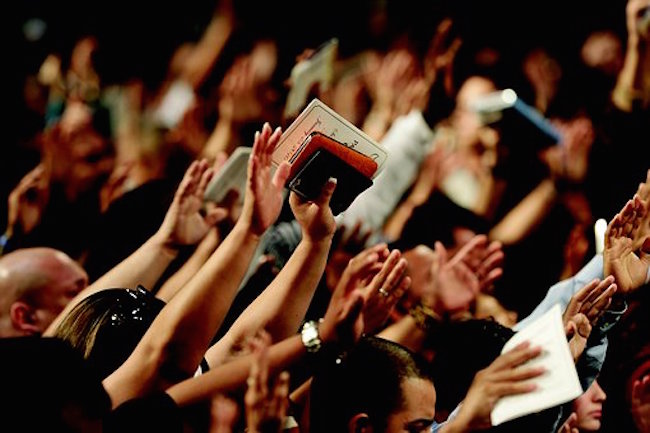The Veil Was Torn in Two by Daniel M. Gurtner for Desiring God
GNN Note – For whatever reason God has put on heart for the past several days the “tearing of the veil”. Not fully understanding what this event meant or why it is so important I set out to find some direction and, hopefully, attain a little deeper understanding. I began by speaking with someone that I hold in very high regard and we discussed his thoughts and what it means. Still not satisfied it seemed I needed to turn to someone with a different perspective – one of the elders in my church has been on mission and a minister for approximately 40 years. I explained that I would reach out to him and hopefully, put this issue to rest.
Then, my friend, sent me this incredible article. The detailed, deep-dive is well worth your time. The author does a marvelous job of explaining all sides of the significants. Not only does the author present the “event” and the reason it is vital to the Christian faith, but he brings to life a much larger story of “why”. Well worth your time and my guess is the coming Christmas season will hold a little deeper meaning having invested in this well written article.
I thank my friend for sending me such a great piece to begin this process.
******
And behold, the veil of the temple was torn in two from top to bottom. (Matthew 27:51 NASB)
From the Bible, we know that the death of Jesus is a glorious truth, foundational to our Christian faith. It grants us peace with God (Romans 5:1), redemption and the forgiveness of sins (Colossians 1:14). But how does the Bible express the significance of Jesus’s death in narratives, like the Gospels? This is exactly what we find at the crucifixion of Jesus and the tearing of the temple curtain (or veil) immediately after his death. Though the tearing of the veil is described in all three Synoptic Gospels (Matthew 27:51; Mark 15:38; Luke 23:45), none of them stops to explain it. Presumably, they thought the event was clear enough to their original readers. But what are we to make of it?
To complicate matters, the account in the Gospel of Matthew recounts a host of extraordinary events that puzzle us today. Yet in them the apostle Matthew, ever with his mind steeped in Israel’s sacred Scriptures, helps us to understand the significance of the historical realities around Jesus’s death. And all this occurs on Good Friday, where we see the goodness of God in Christ on display in anticipation of Easter Sunday.
What Veil Is Matthew Talking About?
It may seem strange to readers that Matthew refers simply to “the” veil of the temple, without any explanation as to which of the many hangings, curtains, and veils in the Old Testament tabernacle and subsequent temple he had in mind. Interpreters must simply presume that Matthew would have expected his readers to know what he meant. Since Matthew makes such frequent appeals to the Old Testament (Matthew 1:22; 2:15, 17, 23; 4:14; 5:17; etc.), presuming it to be an important authority for his readers, it is to the Old Testament we must look.
The word for veil used by Matthew (katapetasma) is a technical term that, in the Greek version of the Old Testament (Septuagint), is used for three different hangings in the tabernacle and temple. But the syntax of Matthew’s statement “veil of the temple” (Matthew 27:51 NASB) suggests only one hanging can be in view: the inner veil before the holy of holies. This veil, described first and most fully in descriptions of the tabernacle, was made of blue, purple, and scarlet yarn and finely twisted linen, with cherubim worked into it by a skilled craftsman (Exodus 26:31; 36:35). It was to be hung before the holy of holies, which was a perfect cube of ten cubits per side. The veil was hung by gold hooks on an acacia-wood frame, which itself was overlaid with gold (Exodus 26:32–33), and the ark of the covenant was kept behind the veil (Exodus 26:33).
Generally, this veil served to separate the holy place from the holy of holies (Exodus 26:33) and shielded the atonement slate1 of the ark (Exodus 26:34). The veil was also used to cover the ark of the testimony while in transport (Numbers 4:5). Sin offerings were made against the veil (Leviticus 4:6, 17), and entry behind it was permitted only for a ritually pure priest, Aaron or a descendent, who would enter behind the curtain on the Day of Atonement (Leviticus 16:2, 12, 15). In Solomon’s temple, patterned after the tabernacle, there was a veil “of blue, purple and crimson yarn and fine linen, with cherubim worked into it” (2 Chronicles 3:14 NIV).
The veil was near the very center of the tabernacle, suggesting a rank of holiness that is also reflected in the quality of its construction. As with the other hangings in the tabernacle, the veil was made of “finely twisted linen” (Exodus 26:31 NIV), a fine grade of linen. The curtains were violet — or, as some suggest, blue-purple or a darker purple compared to the lighter purple. This color was occasionally thought to be the color of the sky,2 which may help account for its association with the heavenly firmament (Genesis 1:6) in later Judaism. This color, which required twelve thousand murex snails to yield only 1.4 grams of pure dye, was known for its association with both divinity and royalty in the ancient Near East, which lends itself to the notion that Yahweh was both the sacred deity and the King enthroned in the midst of Israel within the tabernacle.
The use of royal colors and materials should come as no surprise, as the tabernacle in general and the angelic wings over the veil in particular are often thought to represent the kingly presence of Yahweh among his people. This is confirmed by the description of Yahweh’s presence with Israel as being “enthroned between the cherubim” (1 Samuel 4:4 NIV; 2 Samuel 6:2; 2 Kings 19:15; 1 Chronicles 13:6; Psalm 80:1; 99:1; Isaiah 37:16), which, when coupled with a reference to God’s enthronement “in heaven” (Psalm 2:4 NIV), may support the notion that the holy of holies was thought to be a replica of heaven.
What Did the Veil Do?
Integral to interpreting the tearing of the veil is some explanation of its purpose and function. Surprisingly, few interpreters look explicitly to the Old Testament to address this issue. Yet we find some information about the veil that is imperative for interpreting the meaning of its tearing at the death of Jesus.
As we have seen, the unique workmanship required for the veil is directly related to the presence of cherubim on the veil. These figures symbolized the presence of Yahweh and were woven of elite quality, “the work of a skillful workman” (Exodus 26:31 NASB). In biblical tradition, cherubim served a guardian role from their first appearance in canonical texts, where they guarded “the way to the tree of life” (Genesis 3:24 NASB). They were carved on walls around Solomon’s temple and Ezekiel’s visionary temples (e.g., Ezekiel 10:1–20; 11:22; 41:18–25).
Elsewhere, the cherubim are present at man’s meeting with God (e.g., Exodus 25:22; Numbers 7:89), and they are the winged throne upon which God sits or mounts to fly (2 Samuel 22:11; Psalm 18:10). Yahweh instructs Moses to make “two cherubim out of hammered gold” (Exodus 25:18 NIV), with wings spread upward and overshadowing the atonement slate. They were to be arranged in such a manner as to face each other (Exodus 25:20; cf. Hebrews 9:5), where they were guardians of the atonement slate from which the divine Glory would speak to Israel (Exodus 25:1–22). Perhaps the cherubim on the veil, then, similarly served to guard the way to the sanctuary of God within the holy of holies, as their presence suggests the presence of Yahweh enthroned among his people.




